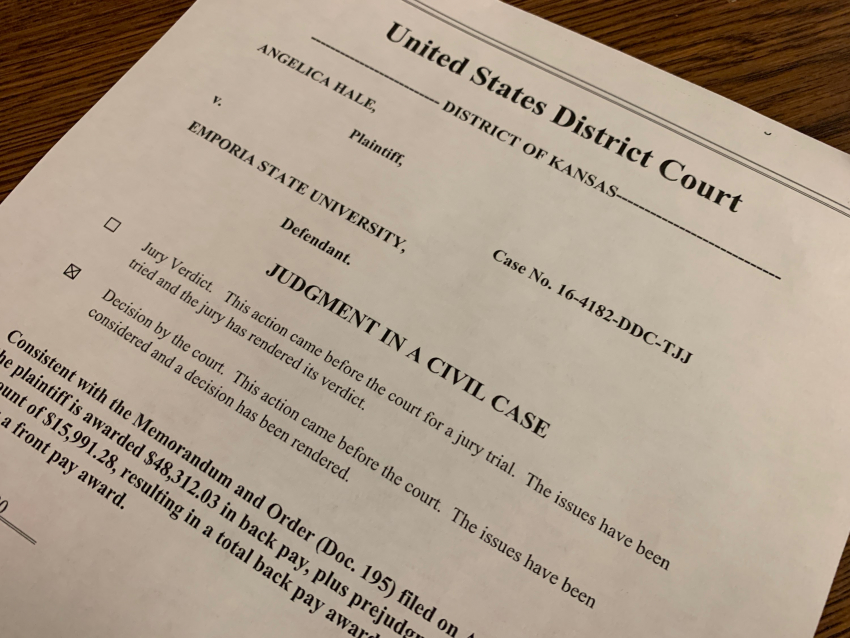Below is a review of the posts (on Facebook, LinkedIn, and Twitter) from the past week. You can check out the full posts by clicking on the links.

in retaliation suit
In the post on Sunday 1/3/21, we saw that a former employee was awarded over $64,000 in backpay, benefits and interest in a lawsuit. Angelica Hale sued Emporia State University. She and her husband, Melvin, a professor, both worked in the School of Library and Information Management (SLIM) Department. In April 2015 Melvin discovered a racial slur on a notebook and reported it to the former dean. Both Angelica and Melvin later reported it to the Provost (and filed a hate crime complaint, the outcome of which is in the post). At that time, Angelica was near the end of her third temporary appointment as a recruiting coordinator. The school was considering hiring her for a marketing position. Instead, it did not renew her temporary position or offer her the marketing position. She resigned. In 2016 Angelica filed a $10M suit against the school, alleging retaliation for reporting the racial slur. After a trial, Angelica ended up with an award for $42,000 in back pay and the other monetary amounts noted in the post. What the backpay is for is also detailed in the post.
TAKEAWAY: Make sure adverse actions have legal support; don’t wait to see the word “defendant” after your (company) name in a lawsuit.

The post on Monday 1/4/21 was about updated forms for implementing FMLA leave – and a reminder to start the new year using the right documents. Hopefully you already know all of this and are ready to use it, but let’s review anyway. The FMLA Notice of Eligibility and Notice of Employee Rights and Responsibilities are now one form with seven topics. More importantly, an employer has to tell an employee who is not eligible for FMLA leave due to a shortage of hours worked just how many hours s/he is short. Other parts of the new form are noted in the post. The Designation Notice was also revised to provide clarification when an employee’s medical certification is insufficient to determine leave eligibility. What it now requires is noted in the post. Finally, the Certificates of Health Care Provider (for a serious health condition of the employee or immediate family member) have been revised. What they now require is listed in the post.
TAKEAWAY: Make sure you have the appropriate FMLA leave forms – you can find them on the Department of Labor’s website using this link: FMLA: Forms | U.S. Department of Labor (dol.gov).

The post on Tuesday 1/5/21 was pretty important: we learned that a District Court enforced a settlement agreed to by email despite the absence of a formal agreement. Ordinarily, parties to an agreement expect that it will not become final and binding until signed by both parties. That thinking may now be upended. In a case in federal court in New York ( so not binding on PA, but perhaps offering some weight), emails ban be seen as an agreement even without the forma signed document or all the terms. How that worked is in the post
TAKEAWAY: Consult a lawyer and make sure settlement correspondence contains enough of the terms and conditions that you will be satisfied with enforcing the agreement even without something else in writing and signed by the parties.

today’s threats
The post on Wednesday 1/6/21 was about how planned communities respond to today’s threats – examining safety in multifamily (condo and HOA) properties. Associations have to think about various ways to protect people and property and to communicate with members. That means thinking about the community’s size, structure and systems, budgets and financial constraints, populations and demographics. And current policies. Some things that were already in the works pre-COVID were fast-tracked. Protocols changed; some examples are in the post, including PPE and deliveries. Things an association should consider before initiating or implementing neighborhood watch programs are also in the post. Associations and residents also have to be mindful of the increase in technology use and how it affects information about the association and members. Other changes during the pandemic are also noted in the post.
TAKEAWAY: Planned community life can seem like life in a bubble, but the bubble can be warm and fuzzy if the association and members work at it, legally and neighborly.

In the post on Thursday 1/7/21 we learned that 2020 concluded with intestate celebrity estates (aka, the lives and deaths of the rich and famous). So, if COVID has not convinced you to review your existing estate plan or put one in place, shame on you. Too bad some celebrities didn’t take that advice and dies without wills. In November 2020 Diego Maradona, soccer star, died. He was only 60. He had 8 children from 6 partners – and did we say NO WILL?!?! He had publicly stated his wishes (see the post) but didn’t get a Will in place. So Argentine law will govern and what it will do is in the post. Another recent celebrity death was Tony Hsieh, former CEO of Zappos, He was only 46 when he died. His estate? $840 million. Both his brother and father applied to be the administrator of his estate and all that is done within the probate will now be public (the state is listed in the post). He had property in another state as well, further complicating estate administration. Finally, Chadwick Boseman dies at age 43 after a long battle with colon cancer. He too had no will. His wife asked the court to be appointed administrator of the estate. How that came about and what she stands to inherit are detailed in the post.
TAKEAWAY: Anyone can die at any age – have your estate plan in place. Consult a lawyer to assist you.

The post on Friday 1/8/21 showed us that Whole Foods responded to the Black Lives Matter lawsuit (with an interesting argument). Remember that some employees filed suit because Whole Foods asked employees not to wear BLM masks and took adverse actin when they did (such as those things noted in the post). Employees said those actions violated Title VII). Whole Foods argued that it was enforcing a neutral dress code (not racial discrimination). What does the dress code provide? See the post. Whole Foods also says that its dress code is within the legal parameters of Title VII. What one employee said relative to Whole Foods’ argument is noted in the post. Other big food retailers also have been taken to task for similar polices – that is also discussed in the post.
TAKEAWAY: make sure any policy is both facially neutral and neutral in implementation; otherwise, get a lawyer on retainer now.

Finally, in the post yesterday 1/9/21, we saw that a McDonald’s franchisor settled an EEOC religious discrimination suit. So, what happened? Allegedly the McDonald’s store refused to hire a Jewish applicant as a part-time maintenance worker. Why? He would not shave his beard for religious reasons, but the store’s grooming policy required that he do so. The purpose of the grooming policy is noted in the post. The applicant offered an alternative (noted in the post), but the employer rejected it. The employer also revised the application form after a charge was filed with the EEOC; the change is noted in the post. The employer would not come to any agreement with the EEOC, so it filed suit. Then it settled. The employer will pay the applicant almost $70,000 and take other non-monetary actions as noted in the post.
TAKEAWAY: Despite existing policies, employers must try to accommodate employees’ sincerely held religious beliefs. Period.

 York, Pennsylvania 17403
York, Pennsylvania 17403